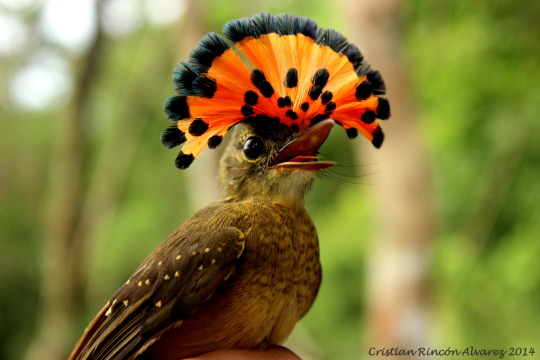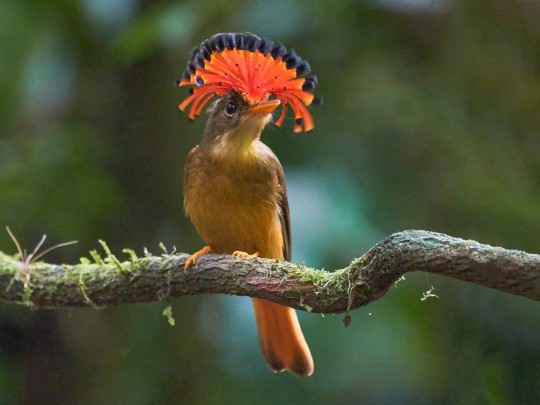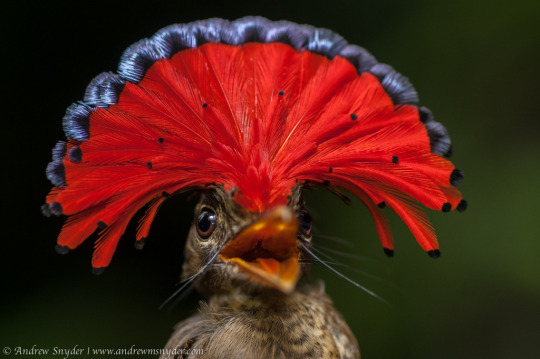#onychorhynchus
Explore tagged Tumblr posts
Text

Atlantic Royal Flycatcher (Onychorhynchus swainsoni), male with crest displayed, family Tityridae, order Passeriformes, endemic to southeastern Brazil
photograph by Kacau Oliveira
#royal flycatcher#tityridae#onychorhynchus#passeriformes#bird#ornithology#animals#nature#south america
2K notes
·
View notes
Text
BOTD: Royal Flycatcher

Photo: Juan Bou Riquer
"Uncommon, medium-sized, overall warm brown flycatcher of humid tropical forest in lowlands. Note the hammerhead crest—very rarely fully raised to reveal spectacular, flame-red fan with violet-blue-black tips. Usually found as singles or pairs in mid-levels of dense forest, where flutters actively after insects. Nest is a straggly mass of dead vegetation up to 3 feet long that hangs from the tip of a branch, often along streambeds. Often detected by single squeaky calls; rarely-heard song variable across range. Occurs from Mexico to Brazil."
- eBird
#birds#royal flycatcher#tropical royal flycatcher#birds of north america#north american birds#flycatchers#sharpbills#passerines#birds of mexico#birds of central america#birding#birdblr#birblr#bird of the day#Onychorhynchus coronatus
36 notes
·
View notes
Text

Behold the Royal Fly Catcher (Onychorhynchus coronatus)! This bird has a colorful secret: Though it’s usually concealed from view, both males and females sport fan-shaped crests on their heads. Typically, this species only uses its headgear during elaborate courtship rituals or while preening. Males’ crests are scarlet while females’ are yellow-orange. It can be found in humid forest habitats across northern South America and southern Mexico.
Photo: cristianrial, CC BY-NC 4.0, iNaturalist
590 notes
·
View notes
Text

Royal Flycatcher (Onychorhynchus)
📷@jc_wings
114 notes
·
View notes
Text

[https://www.inaturalist.org/observations/702160] - for above

[https://www.inaturalist.org/observations/24909644] for above
Tropical Royal Flycatcher - Onychorhynchus coronatus Both male and female birds possess a large and brightly colored fan that is generally red for males and yellow for females, although variation between individuals seems apparent. The impressive fan inspired their Latin species name, corona meaning "crown". Information is limited on whether their impressive display truly serves a dual purpose: both as a factor in sexual selection, as well as a startling warning to would-be predators. This paper examines a few hypotheses. In either case, there is no question that to see their brilliant coronet in all their vivid splendor is a rare treat, as they, like many Tyrannids, keep their crowns mostly hidden.
#bird#air beast#:)#i thought the threat display was proven but it isnt#rather its the popular theory since both sexes have them and they do the whole display only when stressed#a display which is different from their mating display. so. stands to reason. but not Officially Canon so to speak
10 notes
·
View notes
Text
Royal Flycatcher (Onychorhynchus coronatus) display
flickr
A different Royal Flycatcher display from the other video that's been going around, but with the original bander's notes attached. It's a short read!
#I wanted to find a source for the other Amazon Royal Flycatcher I had seen but found this instead#what a wild behavior#flycatchers are very dramatic even if they don't have a crest but this is wild...
5 notes
·
View notes
Text
La muestra nos aproxima a la riqueza de la fauna del trópico sudamericano Mosquero real amazónico, ‘Onychorhynchus coronatus’ / Viviane Chonchol El Museo Nacional de Ciencias Naturales de Madrid (MNCN-CSIC) inaugura hoy, a las 19 horas, la exposición temporal Inventario desde adentro. Acuarelas de fauna neotropical por Viviane Chonchol. La muestra, que se podrá visitar hasta el 9 de julio en el edificio de Biodiversidad, se compone de veintidós obras originales de aves y mamíferos del Neotrópico. El color es una de las señas de identidad de la ilustradora naturalista y en su proceso creativo incluyó, además de la observación personal como amante de la naturaleza, la investigación y consultas con expertos para verificar la fidelidad de las representaciones, su adecuada identificación y su distribución Viviane Chonchol, realizó gran parte de las obras expuestas durante la pandemia recurriendo al recuerdo y a la fotografía. El resultado, además de aliviar los momentos de aislamiento, fue una serie de ilustraciones que, a modo de catálogo, retratan la fauna de esta región y pretenden ser una llamada de atención para su registro y conservación por su amenazada situación. “Durante el confinamiento por la pandemia por COVID 19, la investigación me acercó a una mayor comprensión de la anatomía animal. La aproximación al mundo natural por medio de la fotografía me permitió salir de los confines de mi hogar. Esa libertad que traía a mi casa, a través del colorido de las aves, me ayudó a aliviar los momentos de reclusión”, apunta la autora de las obras “De nuevo apostamos por la unión entre arte y ciencia, un indispensable en las salas del museo, e invitamos a los visitantes a conocer la obra de Viviane Chonchol. Su original estilo y técnica nos acercan a la fascinante fauna del trópico sudamericano”, comenta Borja Milá, vicedirector de exposiciones del MNCN. La inauguración de Inventario desde adentro, que se podrá visitar hasta el 9 de julio en el edificio de Biodiversidad, será el 9 de abril a las 19 horas. En ella intervendrán Borja Milá, vicedirector de exposiciones del MNCN y la propia ilustradora, Viviane Chonchol. Tras el turno de palabra habrá un recorrido libre por la muestra. Además, el 10 de abril tendrá lugar la conferencia Aves de la claridad deslumbrante, un encuentro con Viviane Chonchol, Federica Palomero (historiadora del arte) y David Ascanio (fotógrafo de naturaleza) que, organizado por la Sociedad de Amigos del Museo (SAM), se podrá seguir de forma presencial y virtual. Sobre la ilustradora Viviane Chonchol vive y trabaja en Caracas, Venezuela. Tras graduarse como diseñadora gráfica en el Instituto de Diseño Hans Neumann, trabajó en el área de la imagen corporativa y el diseño editorial. Se aproximó a la técnica de la acuarela a través de diseños relacionados con la conservación de la biodiversidad. Es una ávida senderista que refleja en sus obras la fascinación que le produce la fauna en su entorno. Fuente mncn

View On WordPress
0 notes
Video
youtube
Lucid Lucia - Onychorhynchus
1 note
·
View note
Text
Creature Awaits #170
Each week I plan to feature an amazing creature, admiring God's fantastic artistry. Hopefully it’ll brighten someone’s day to see something new and interesting if they haven’t seen it before. : )
Welcome to the conclusion of "Cool Hair, Bro!" month, where we've featured animals with awesome "hairstyles"... : )

(Beautiful still taken by skilled photographer, Richard Gibbons (CC BY-NC 2.0))
The Northern Royal Flycatcher
Scientific Name: Onychorhynchus mexicanus
Region: Southern Mexico, Central America and the northwestern edge of South America
Size: About 6.5"-7.1" (~16.5cm-18cm) long from head through tail
Interesting Notes: The crest found across all four members of the Royal Flycatcher (Onychorhynchus) genus usually looks like a slick, striped streak running across the top of their heads; however, during courtship, after mating, while preening and when startled or handled, these feathers fan out in a unique, beautiful display (as pictured above.) Both male and female sport this style - with the male's "hair" being vermilion, and the female's being a more golden orange.
#creatureawaits#Northern Royal Flycatcher#Royal Flycatcher#Onychorhynchus mexicanus#Onychorhynchus#beautiful birds#interesting birds#strange plumage#unique plumage
2 notes
·
View notes
Photo

Atlantic Royal Flycatcher (Onychorhynchus swainsoni)
© João Sérgio Barros
#atlantic royal flycatcher#onychorhynchus swainsoni#tityridae#passeriformes#joão sérgio barros#birds
172 notes
·
View notes
Text

Atlantic Royal Flycatcher (Onychorhynchus swainsoni), male with crest displayed, family Tityridae, order Passeriformes, endemic to southeastern Brazil
photograph by Daniel Alfenas
#royal flycatcher#flycatcher#onychorhynchus#tityridae#passeriformes#bird#ornithology#south america#animals#nature
931 notes
·
View notes
Photo

Royal Flycatcher (Onychorhynchus coronatus)
© sylvain Uriot
56 notes
·
View notes
Photo

Amazonian Royal Flycatcher (Onychorhynchus coronatus)
© Andrew Snyder
35 notes
·
View notes
Text

Atlantic royal flycatcher (Onychorhynchus swainsoni)
~ Photo: @my_little_sensor
103 notes
·
View notes
Text

Day 17, "Ornament" - Amazonian Royal Flycatcher (Onychorhynchus coronatus)
Both the males and females of this species sport an ornate headdress.
7 notes
·
View notes
Photo

Amazonian Royal Flycatcher (Onychorhynchus coronatus)
Family: Sharpbill Family (Oxyruncidae)
IUCN Conservation Status: Least Concern
Found in wetlands and rainforests surrounding the Amazon basin of South America, the Amazonian Royal Flycatcher is best known for the striking collapsible crest of orange and black feathers seen on the heads of males, such as the individual pictured above. When not in use, the crest folds up in a manner similar to a paper fan and lies against the back of the head and neck. Male Amazonian Royal Flycatchers primarily use their crests when attempting to court females, but it has been suggested that they may also use them to appear larger in an effort to ward off predators when they feel threatened (notably, males almost always erect their crest when being handled by humans, supporting the theory that this is a defensive behaviour.) This species feeds on small arthropods such as flies, cicadas, dragonflies, butterflies, grasshoppers and ticks, and nests in thin, narrow nests which it suspends dangling from branches and often constructs above water, possibly to make them harder for predators and egg-thieves to reach. After mating, female Amazonian Royal Flycatchers lay a clutch of around 2 eggs which they incubate without the assistance of males.
-----------------------------------------------------------------------------
Image Source: https://www.inaturalist.org/observations/71898563
#amazonian royal flycatcher#flycatcher#royal flycatcher#royal flycatchers#bird#birds#zoology#biology#Ornithology#animal#animals#wildlife#south american wildlife
123 notes
·
View notes